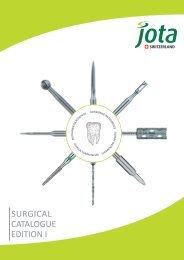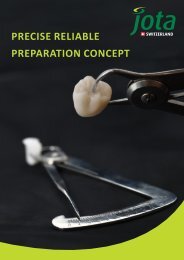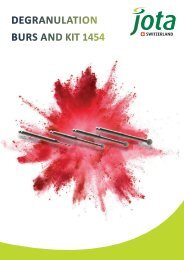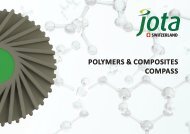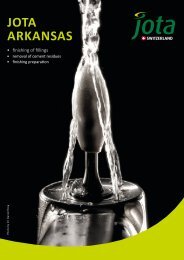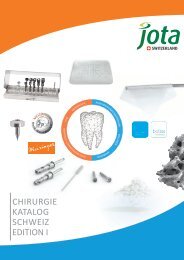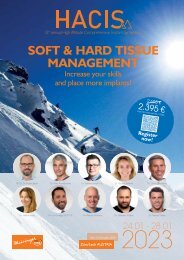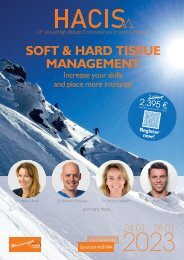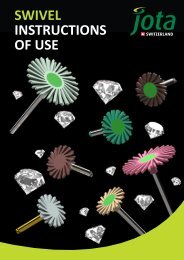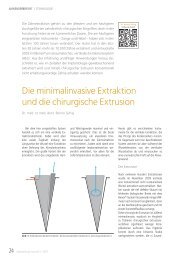Jota essentials
You also want an ePaper? Increase the reach of your titles
YUMPU automatically turns print PDFs into web optimized ePapers that Google loves.
JOTA<br />
ESSENTIALS CATALOGUE<br />
DENTISTRY & LABORATORY
DENTAL INSTRUMENTS<br />
BE PART OF JOTA WORLD<br />
Global Presence in more than 80 countries<br />
<strong>Jota</strong> AG & <strong>Jota</strong> do Brasil<br />
represented countries<br />
future projects<br />
1
DENTAL INSTRUMENTS<br />
GENERAL INFORMATION 2 - 4<br />
DENTISTRY DIAMONDS 6 - 14<br />
DENTISTRY CARBIDES 13 - 14<br />
DENTISTRY SURGERY 15<br />
DENTISTRY POLISHERS 16-17<br />
DENTISTRY ABRASIVES 18<br />
LABORATORY DIAMONDS 20 - 21<br />
LABORATORY CARBIDES 22 - 23<br />
LABORATORY POLISHERS 24 - 26<br />
LABORATORY ABRASIVES 27 - 28<br />
APPLICATION, SAFETY, CLEANING INSTRUCTION 29 - 36<br />
2
OVERVIEW<br />
ORDER INFORMATION & GENERAL INFORMATION<br />
SHANK TYPES<br />
DESCRIPTION ↔ ISO<br />
Order Number<br />
660.FG.025.ARK<br />
Straight handpiece<br />
2,35 mm 44,5 mm 104 HP<br />
FIGURE 660<br />
SHANK<br />
FG<br />
Right angle<br />
2,35 mm 22 mm 204 RA<br />
Ø 025<br />
TYPE<br />
ARK<br />
L mm 7.0<br />
5<br />
660.RA.025.ARK<br />
Right angle, long<br />
Friction Grip<br />
2,35 mm 26 mm 205 RAL<br />
1,60 mm 19 mm 314 FG<br />
ALT.<br />
SHANK<br />
RA<br />
Optional shank if available<br />
Friction Grip, long<br />
1,60 mm 21 mm 315 FGL<br />
L mm<br />
Length of workingpart<br />
Packaging unit<br />
Friction Grip, extra long<br />
1,60 mm 25 mm 316 FGXL<br />
Rotation Speed<br />
APP<br />
Application<br />
* The total length of instruments can be shorter or longer<br />
according to type of construction.<br />
3
RECOMMENDED SPEED<br />
DIAMETER<br />
Ø<br />
DIAMONDS & CARBIDES<br />
Friction Grip<br />
FG<br />
Right Angle RA<br />
Straight<br />
Handpiece<br />
HP<br />
Straight<br />
Handpiece<br />
HP<br />
min -1<br />
ABRASIVES<br />
Friction Grip<br />
FG<br />
Right Angle RA<br />
These are general guide speeds, specific recommended<br />
speeds for surgery instruments can be found on<br />
the product related page.<br />
To over exceed the given rotation speed can lead to<br />
impairment of the eficiency of the products and/or<br />
be of danger for the patient as well as the user. The<br />
choice of the working speed for a specifc application<br />
case is determined by the material subsequently to be<br />
used, the instrument power, and the maximal down<br />
force pressure ultimately decided upon by the user.<br />
005<br />
006<br />
007<br />
008<br />
300.000<br />
009<br />
010<br />
012<br />
014<br />
016 280.000<br />
018 250.000<br />
021 210.000<br />
023 190.000<br />
025 180.000<br />
027 160.000<br />
028<br />
029 150.000<br />
030<br />
45.000<br />
20.000<br />
15.000<br />
15.000 –<br />
20.000<br />
80.000 –<br />
100.000<br />
15.000 –<br />
25.000<br />
> To produce optimum results, turn the rotary<br />
instruments at their recommended speeds.<br />
> Long, pointed instruments tend to oscillate if their<br />
maximum permissible speeds are exceeded - this<br />
may destroy the instruments.<br />
> If the diameter of the working part exceeds that of<br />
the shank, powerful centrifugal forces may build<br />
up at high speeds which may bend the shank and/<br />
or fracture the instruments. The maximum permissible<br />
speed must therefore never be exceeded.<br />
> The recommended speeds are shown in the adjacent<br />
diagram.<br />
> The maximum permissible working speeds are<br />
indicated in the manufacturer’s information on the<br />
packaging.<br />
> Non-adherence to the maximum permissible<br />
speeds increases the risk of accidents.<br />
Recommended speeds<br />
4
DENTISTRY<br />
Dentistry<br />
5
DIAMONDS<br />
DENTISTRY<br />
COLOUR CODE GRAIN ISO SIZE OF GRAINS RECOMENDED APPLICATION<br />
green ring coarse = G 534 107-181 µm Pre-grinding<br />
blue ring medium 524 64-126 µm Universal grinding<br />
red ring fine = F 514 27-76 µm Burnishing<br />
yellow ring extra fine = EF 504 10-36 µm Prefinishing of composites<br />
<strong>Jota</strong> Diamonds basically consist of the shank plus a hardened, stainless profiled body<br />
which is coated with only selected diamond grains using state-of-the-art electroplating<br />
techniques. This guarantees an extremely homogeneous, secure and long-lasting<br />
diamond coating. A choice of up to four different grain sizes is also available for an<br />
even better result.<br />
The use of coarse-grained diamonds (ISO 534) can lead to increased heat generation.<br />
When using these products, special care should therefore be taken to<br />
ensure sufficient cooling and minimal application force. After using these diamond<br />
instruments, finishing should be performed in order to obtain an optimal surface<br />
roughness / smoothness.<br />
6
DIAMONDS<br />
DENTISTRY<br />
1 2 3 4 5 6 7 8 9 10 11<br />
FIGURE 801 801 801 801 801 801 801 801 801 801<br />
SHANK FG FG FG FG FG FG FG FG FGXL FGXL<br />
Ø 008 010 012 014 016 018 021 023 014 018<br />
L mm -- -- -- -- -- -- -- -- -- --<br />
5 5 5 5 5 5 5 5 5 5<br />
APP 4, 5, 6, 7<br />
FIGURE 801G 801G 801G 801G 801G 801G 801G 801L 801L 801LG<br />
SHANK FG FG FG FG FG FG FG FG FG FG<br />
Ø 010 012 014 016 018 021 023 014 016 014<br />
L mm -- -- -- -- -- -- -- -- -- --<br />
5 5 5 5 5 5 5 5 5 5<br />
APP 4, 5, 6, 7 4, 5, 8<br />
7
DIAMONDS<br />
DENTISTRY<br />
FIGURE 801LG 805 805 805 805 808 830 830 830 830G<br />
SHANK FG FG FG FG FG FG FG FG FG FG<br />
Ø 016 010 012 014 016 012 018 021 023 023<br />
L mm -- 1,0 1,5 1,5 1,5 2,7 4,5 5,0 5,0 5,0<br />
5 5 5 5 5 5 5 5 5 5<br />
APP 4, 5, 8 4, 5, 6 6, 7<br />
FIGURE 830EF 830EF 830EF 830F 830F 830F 833EF 833 833F 833G<br />
Shank FG FG FG FG FG FG FG FGL FGL FGL<br />
Ø 016 021 023 018 021 023 023 023 023 023<br />
L mm 4,5 5,0 5,0 4,5 5,0 5,0 4,2 4,2 4,2 4,2<br />
5 5 5 5 5 5 5 5 5 5<br />
APP 1, 6, 7 1, 6, 7<br />
8
DIAMONDS<br />
DENTISTRY<br />
1 2 3 4 5 6 7 8 9 10 11<br />
FIGURE 815 815 851L 835 835 835 837 837 837LG 837LG<br />
SHANK FG FG FG FG FG FG FG FG FG FG<br />
Ø 026 022 016 008 010 012 012 014 012 014<br />
L mm 1,2 1,2 8,0 3,0 3,5 3,5 6,0 6,0 8,0 8,0<br />
5 5 5 5 5 5 5 5 5 5<br />
APP 4, 7 4, 7, 8 4, 6 ,7 4, 6, 7<br />
FIGURE 848 848 848 845R 845R 845R 850 850 850F 850F<br />
Shank FG FG FG FG FG FG FG FG FG FG<br />
Ø 014 016 018 016 018 025 014 016 014 016<br />
L mm 10,0 10,0 10,0 4,0 4,0 4,0 8,0 8,0 8,0 8,0<br />
5 5 5 5 5 5 5 5 5 5<br />
APP 4, 6, 7 4, 5, 7 4, 6, 7<br />
9
DIAMONDS<br />
DENTISTRY<br />
FIGURE 850G 850G 850G 852 852 852F 852F 852G 852G 858<br />
SHANK FG FG FG FG FG FG FG FG FG FG<br />
Ø 012 014 016 014 016 014 016 014 016 010<br />
L mm 8,0 8,0 8,0 10,0 10,0 10,0 10,0 10,0 10,0 8,0<br />
5 5 5 5 5 5 5 5 5 5<br />
APP 4, 5, 7 4, 6, 7 2, 4, 6, 7<br />
FIGURE 859 859 859 859F 859F 859G 859L 859L 859L 862<br />
SHANK FG FG FG FG FG FG FG FG FG FG<br />
Ø 010 012 014 012 014 014 010 012 014 010<br />
L mm 10,0 10,0 10,0 10,0 10,0 10,0 12,0 12,0 12,0 8,0<br />
5 5 5 5 5 5 5 5 5 5<br />
APP 2, 4, 6, 7 2, 3, 4, 6, 7 4, 6, 7<br />
10
DIAMONDS<br />
DENTISTRY<br />
1 2 3 4 5 6 7 8 9 10 11<br />
FIGURE 862 862EF 862EF 862F 862F 862G 862G 863 863EF 863F<br />
SHANK FG FG FG FG FG FG FG FG FG FG<br />
Ø 012 010 012 010 012 010 012 012 012 012<br />
L mm 8,0 8,0 8,0 8,0 8,0 8,0 8,0 10,0 10,0 10,0<br />
5 5 5 5 5 5 5 5 5 5<br />
APP 1, 4, 6, 7 4, 6, 7<br />
FIGURE 863G 868 868 868F 868F 868G 868G 558 558 558F<br />
SHANK FG FG FG FG FG FG FG FG FG FG<br />
Ø 012 012 014 012 014 012 014 013 015 013<br />
L mm 10,0 8,0 8,0 8,0 8,0 8,0 8,0 10,0 10,0 10,0<br />
5 5 5 5 5 5 5 5 5 5<br />
APP 4, 6, 7 7 7<br />
11
DIAMONDS<br />
DENTISTRY<br />
COOL & EFFICIENT - (CE) DIAMOND<br />
FIGURE 558F 889LF 890F 890LEF 895F 820F<br />
SHANK FG FG FG FG FG FG<br />
Ø 015 009 010 008 016 016<br />
L mm 3,5 3,0 3,0 3,5 5,0<br />
5 5 5 5 5 5<br />
APP 7 1, 2, 4, 6 1, 2, 4, 6, 9 6 1, 2, 6, 9<br />
ZIRCONIA DIAMONDS<br />
FIGURE 837D<br />
SHANK FG<br />
Ø 014<br />
L mm 7,0<br />
5<br />
APP 7, 11<br />
FIGURE Z850 Z850F Z838L Z818<br />
SHANK FG FG FG FG<br />
Ø 018 018 014 060<br />
L mm 8,0 8,0 6,0 0,6<br />
5 5 5 2<br />
APP 11<br />
12
CARBIDES<br />
DENTISTRY<br />
1 2 3 4 5 6 7 8 9 10 11<br />
FIGURE C1 C1 C1 C1 C1 C1 C1 C1S C1S C1S<br />
SHANK FG FG FG FG FG RA RA FG FG FG<br />
Ø 010 012 014 016 018 021 023 014 016 018<br />
ALT.<br />
SHANK<br />
5 5 5 5 5 5 5 5 5 5<br />
RA RA RA RA RA RA RA RA<br />
APP 3, 4, 5 4, 5<br />
FIGURE C1S C1S C1S C2 C2 C7 C7 C21 C21 C23R<br />
SHANK RAL RAL RAL FG FG FG FG FG FG FG<br />
Ø 014 018 023 012 014 008 010 010 012 012<br />
L mm -- -- -- 1,2 1,4 1,8 2,0 4,1 4,1 4,1<br />
ALT.<br />
SHANK<br />
5 5 5 5 5 5 5 5 5 5<br />
RA RA RA<br />
APP 4, 5 4 4 2, 3, 4, 6, 7 2, 4, 6<br />
13
CARBIDES<br />
DENTISTRY<br />
FIGURE C23R C31 C31R C33 C33 CX21 CX23R RRC31R RRC7 C31A<br />
SHANK RA FG FG FG FG FG FG FG FG FG<br />
Ø 016 010 012 010 012 012 012 012 008 012<br />
L mm 4,5 4,1 4,1 4,1 4,1 4,0 4,1 4,0 2,0 5,3<br />
5 5 5 5 5 5 5 5 5 5<br />
APP 2, 4, 6 3, 4, 7 2, 4, 7 4, 6, 7 5, 11 5, 11 5, 11 5 5<br />
FIGURE C379 C379 C244K C48L<br />
COLOUR CODE<br />
DESCRIPTION<br />
SHANK FG FG FG FG<br />
Ø 018 023 016 012<br />
green ring<br />
coarse<br />
high cutting<br />
efficiency<br />
L mm 3,5 4,2 8,0 8,0<br />
5 5 5 5<br />
black ring<br />
super coarse<br />
amalgam<br />
remover<br />
ALT.<br />
SHANK<br />
RA<br />
RA<br />
APP 2, 4, 7 1, 2, 6, 7 1, 2, 6, 7<br />
Finishing burs<br />
without Ring<br />
regular<br />
8-12 Blades<br />
14
SURGERY<br />
DENTISTRY<br />
1 2 3 4 5 6 7 8 9 10 11<br />
FIGURE C151 C152<br />
SHANK FGL FGL<br />
Ø 016 014<br />
L mm 10,7 9,0<br />
ALT.<br />
SHANK<br />
2 2<br />
FGXL<br />
APP 3 2, 3, 6<br />
ORAL & MAXILLOFACIAL SURGERY RECOMMENDED MAXIMUM<br />
Friction Grip FG 80‘000 min-¹ 100‘000 – 200‘000 min-¹<br />
15
POLISHERS<br />
Recomended Suitable Diamond Polishers<br />
DENTISTRY<br />
POLISHERS<br />
9832 9834<br />
Composite, Enamel, Hybrid/Nano ceramics, Acrylics<br />
9812G 9813G 9812M 9813M 9812F 9813F<br />
Lithium disilicate, LS-ZIR, Feldspat ceramics, Leucite ceramics Zirconium oxide, Non precious alloys<br />
9501M 9501F<br />
Amalgam, Non precious alloys, Precious alloys, Titanium<br />
ZIR9863M ZIR9863F<br />
Zirconium oxide, Zirconium reinforced lithium silicate (LS-ZIR)<br />
LS9873M LS9873F<br />
Lithium disilicate Ceramic<br />
9150 9837<br />
Composite, Enamel, Hybrid/Nano ceramics, Acrylics<br />
Non precious alloys<br />
9765M 9765F<br />
Composite, Hybrid/Nano ceramics, Acrylics<br />
16
POLISHERS<br />
DENTISTRY<br />
FIGURE LS9873M LS9873F ZIR9863M ZIR9863F 9834 9832 9765M 9765F 9150 9837<br />
SHANK RA RA RA RA RA RA RA RA RA RA<br />
Ø 140 140 140 140 040 060 055 055 140 140<br />
L mm 1,6 1,6 1,6 1,6 6,0 6,5 8,8 8,8 1,6 1,6<br />
2 2 2 2 2 2 2 2 2 2<br />
10‘000 - 12‘000 rpm 3‘000 - 10‘000 rpm 3‘000 - 8‘000 rpm<br />
7‘000 - 12‘000<br />
rpm<br />
3‘000 - 8‘000<br />
rpm<br />
FIGURE 9501M 9501F 9813G 9812G 9813M 9812M 9813F 9812F<br />
SHANK RA RA RA RA RA RA RA RA<br />
Ø 030 030 060 040 060 040 060 040<br />
L mm 6,0 6,0 7,5 10,0 7,5 10,0 7,5 10,0<br />
5 5 5 5 5 5 5 5<br />
7‘000 - 12‘000 rpm<br />
17
ABRASIVES<br />
DENTISTRY<br />
Recomended Suitable Not suitable<br />
ABRASIVES<br />
ZIRCONIA CERAMIC ACRYLICS DENTIN METAL KOMPOSIT RECOMMENDED APPLICATION<br />
DIAMOND STONE (SD)<br />
ARKANSAS (ARK)<br />
GLACE PREP (GP)<br />
PREPARING PORCELAIN AND ACRYLICS<br />
FINISHING/PRE-POLISHING OF ALL TYPES OF<br />
FILLING MATERIALS AS WELL AS NATURAL TOOTH<br />
PREPARING ZIRCONIA AND CERAMIC<br />
FIGURE 645 661 666 601<br />
SHANK FG FG FG FG<br />
Ø 028 025 025 030<br />
TYPE ARK ARK ARK ARK<br />
L mm 7,0 7,0 6,5 --<br />
ALT.<br />
SHANK<br />
5 5 5 5<br />
RA RA RA RA<br />
FIGURE 6198 GP662 SD661F<br />
SHANK RA RA RA<br />
Ø 023 035 025<br />
TYPE<br />
ARK<br />
L mm 8,0 7,5 7,0<br />
ALT.<br />
SHANK<br />
5 5 2<br />
FG<br />
FG<br />
18
LABORATORY<br />
Laboratory<br />
19
DIAMONDS<br />
LABORATORY<br />
DIAMOND DISCS<br />
1 2 3 4 5 6 7 8 9 10 11 12<br />
Recomended Suitable Not suitable<br />
acrylics cutting<br />
acrylic<br />
seperation<br />
ceramic cutting<br />
porcelain<br />
seperation<br />
zirconium oxide<br />
plaster<br />
915D<br />
super flexibles<br />
916D<br />
rigid<br />
932D<br />
flexible<br />
935D<br />
flexible<br />
947D<br />
super flexibles<br />
365D<br />
flexible<br />
FIGURE 915DF 916D 932D 935D 947DEF 365D<br />
SHANK HP HP HP HP HP HP<br />
Ø 190 220 220 220 220 300<br />
L mm 0,20 0,50 0,30 0,30 0,15 0,30<br />
1 1 1 1 1 1<br />
APP 5 3, 5 2<br />
20
DIAMONDS<br />
LABORATORY<br />
1 2 3 4 5 6 7 8 9 10 11 12<br />
FIGURE 801 801 830F 837 850 859 863<br />
SHANK HP HP HP HP HP HP HP<br />
Ø 009 033 023 027 023 010 016<br />
L mm 0,9 3,3 5,0 6,0 8,0 10,0 10,0<br />
5 2 5 5 5 5 5<br />
APP 4, 5, 8, 9, 10, 11, 12<br />
FIGURE Z818 Z838L Z850 Z850F<br />
SHANK FG FG FG FG<br />
Ø 060 014 018 018<br />
L mm 0,7 6,0 8,0 8,0<br />
2 5 5 5<br />
APP 4, 8, 9, 10, 11, 12<br />
21
CARBIDES<br />
LABORATORY<br />
Recomended Suitable Not suitable<br />
CARBIDES<br />
PLASTER<br />
PRECIOUS<br />
ALLOY<br />
SEMI-<br />
PRECIOUS<br />
ALLOY<br />
NON<br />
PRECIOUS<br />
ALLOY<br />
MODEL<br />
CASTING<br />
ALLOYS<br />
TITANIUM /<br />
TITANIUM<br />
ALLOYS<br />
ACRYLICS<br />
TRAY<br />
MATERIAL<br />
CERAMICS<br />
C- PLAIN CUT STANDARD<br />
CX-F<br />
X-CUT FINE<br />
CX-<br />
X-CUT STANDARD<br />
CX-G<br />
X-CUT COARSE<br />
FIGURE C1 C1 CX23SR C33 C71 CX23 CQ251 CX251 CX79<br />
SHANK HP HP HP HP HP HP HP HP HP<br />
Ø 008 023 010 016 031 023 060 060 045<br />
L mm 4,2 4,5 11,5 14,7 14,7 12,7<br />
5 5 5 5 1 1 1 1 1<br />
APP 1, 2, 3, 4, 6, 7 1, 2, 3, 4 1, 2, 3, 4, 7 1, 2, 4, 8, 9, 10, 11, 12<br />
22
CARBIDES<br />
LABORATORY<br />
FIGURE CX75F CX251F CX77MF CX251G<br />
SHANK HP HP HP HP<br />
Ø 060 060 023 060<br />
L mm 12,0 14,7 5,5 14,7<br />
1 1 1 1<br />
APP 1, 4, 5, 8, 9, 10, 11, 12 3, 8, 9, 10, 11, 12<br />
23
POLISHERS<br />
LABORATORY<br />
POLISHERS<br />
9105M<br />
Universell<br />
9310G 9310EF 9315M 9315F<br />
Non precious alloy, titanium, precious alloy<br />
9571M 9572G 9574F<br />
Acrylics, PEEK<br />
9801G 9801M 9801F 9803M 9803F 9804M 9804F 9805M 9805F<br />
Zirconium reinforced lithium silicate, leucite reinforced ceramic, lithium disilicate, feldspar ceramic, zirconium oxide Zirconium oxide, non precious alloys<br />
9840<br />
Composite, hybrid ceramic, acrylics, PEEK<br />
LS9875M LS9876F LS9877F LS9878F LS9878M<br />
Lithium disilicate, leucite reinforced ceramic, zirconium reinforced lithium silicate<br />
Feldspar ceramic<br />
ZIR9865M ZIR9866M ZIR9867F ZIR9868F ZIR9868M<br />
zirconium oxide, zirconium reinforced lithium disilicate<br />
24
POLISHERS<br />
LABORATORY<br />
FIGURE 9103G 9105M 9107G 9310G 9310EF 9315M 9315F 9571M 9572G 9574F<br />
SHANK UM HP UM HP HP HP HP HP HP HP<br />
Ø 220 050 220 050 050 055 055 100 100 055<br />
L mm 3,0 16,0 4,0 16,0 16,0 18,0 18,0 20,0 24,0 16,0<br />
10 5 10 5 5 5 5 5 5 5<br />
7‘000 - 10‘000 rpm 7‘000 - 12‘000 rpm 5‘000 - 7‘000 rpm<br />
FIGURE 9801G 9801M 9801F 9803M 9803F 9804M 9804F<br />
SHANK HP HP HP HP HP HP HP<br />
Ø 260 260 260 040 040 110 110<br />
L mm 2,0 2,0 2,0 13,0 13,0 2,0 2,0<br />
1 1 1 2 2 2 2<br />
5‘000 - 10‘000 rpm 5‘000 - 12‘000 rpm 7‘000 - 12‘000 rpm<br />
25
POLISHERS<br />
LABORATORY<br />
Recomended Suitable Diamond Polishers<br />
FIGURE 9805M 9805F 9840 LS9875M LS9876F LS9877F LS9878F LS9878M<br />
SHANK HP HP HP HP HP HP HP HP<br />
Ø 140 140 140 260 040 110 140 140<br />
L mm 1,6 1,6 1,6 2,0 13,0 2,0 1,6 1,6<br />
2 2 2 1 2 1 2 2<br />
7‘000 - 12‘000 rpm<br />
3‘000 - 10‘000<br />
rpm<br />
7‘000 - 12‘000 rpm<br />
FIGURE ZIR9865M ZIR9866M ZIR9867F ZIR9868F ZIR9868M<br />
SHANK HP HP HP HP HP<br />
Ø 260 040 110 140 140<br />
L mm 2,0 13,0 2,0 1,6 1,6<br />
1 2 1 2 2<br />
7‘000 - 12‘000 rpm<br />
26
ABRASIVES<br />
LABORATORY<br />
ABRASIVES<br />
ZIRCONFLEX<br />
(SZ)<br />
DIAMOND<br />
STONE (SD)<br />
GRÜN (GRN)<br />
ROSA (PNK) BRAUN (DBR)<br />
DER BLAUE<br />
(BLU)<br />
zirconium oxide<br />
zirconium<br />
reinforced lithium<br />
disilicate<br />
composite<br />
leucite reinforced<br />
ceramic<br />
lithium disilicate<br />
FIGURE 732 733 B493<br />
SHANK HP HP HP<br />
Ø 050 035 080<br />
TYPE DBR DBR BLU<br />
L mm 12,5 10,5 20,0<br />
5 5 1<br />
feldspar ceramic<br />
PEEK<br />
non precious alloy<br />
acrylics<br />
soft reline<br />
precious alloy<br />
27
ABRASIVES<br />
LABORATORY<br />
Recomended<br />
Suitable<br />
FIGURE SZ652R SZ660 SZ715 SZ736 SD652RF SD660F SD716F SD732F<br />
SHANK HP HP HP HP HP HP HP HP<br />
Ø 035 040 160 065 035 040 150 050<br />
TYPE<br />
L mm 10,5 12,0 0,9 7,0 10,5 12,0 3,0 12,5<br />
2 2 1 2 2 2 1 2<br />
FIGURE 642 652 662 648 662 665 731 732 733 734<br />
SHANK HP HP HP HP HP HP HP HP HP HP<br />
Ø 050 035 035 020 035 060 065 050 035 085<br />
TYPE GRN GRN GRN PNK PNK PNK DBR PNK PNK PNK<br />
L mm 12,5 10,5 7,5 6,0 7,5 12,0 13,0 12,5 10,5 4,0<br />
5 5 5 5 5 5 5 5 5 5<br />
28
OVERVIEW<br />
APPLICATIONS<br />
ICONS LABORATORY<br />
1<br />
Model casting technique<br />
5<br />
Veneer and ceramic technique<br />
9<br />
Thermodisinfector<br />
2<br />
Model casting<br />
6<br />
Orthodontics<br />
10<br />
Steriliser operating with air of 180 °C<br />
3<br />
Acrylic technique<br />
7<br />
Oral surgery<br />
11<br />
Ultrasonics<br />
4<br />
Crown and bridge technique<br />
8<br />
Autoclave operating at 135 °C<br />
12<br />
Drill bath<br />
ICONS DENTISTRY<br />
1<br />
Prophylaxis<br />
5<br />
Removal of old fillings<br />
9<br />
Smoothing of tooth roots<br />
2<br />
Orthodontics<br />
6<br />
Treatment of fillings<br />
10<br />
Oral implantology<br />
3<br />
Oral surgery<br />
7<br />
Preparation of crowns<br />
11<br />
Cutting of crowns<br />
4<br />
Preparation of cavities<br />
8<br />
Treatment of root-canal<br />
29
OVERVIEW<br />
CLEANING PROCEDURE<br />
INSTRUCTIONS FOR PROCESING &<br />
GENERAL APPLICATION AND SAFETY INSTRUCTIONS<br />
Instructions for the processing<br />
(Cleaning, disinfection, and sterilization)<br />
of instruments from <strong>Jota</strong> AG<br />
Issued: January 2022<br />
The medical devices produced and sold by <strong>Jota</strong> AG<br />
are re-usable unless their label contains explicit<br />
information to the contrary. However, as a rule, it<br />
is the sole responsibility of the doctor/expert using<br />
the devices to decide whether, depending on the<br />
respective case and the potential wear and tear of<br />
the products, he can re-use the products and how<br />
frequently he uses them. In case of doubt, it is<br />
always advisable to discard the products early and<br />
to replace them. The manufacturer <strong>Jota</strong> AG cannot<br />
guarantee the faultless function and performance<br />
of the products combined with a maximum degree<br />
of safety if the products are overused. These reprocessing<br />
instructions apply in principle to all medical<br />
devices making up the product range supplied by<br />
<strong>Jota</strong> AG. Any particular features and/or exclusions<br />
that only concern individual items or groups of<br />
items are referred to separately.<br />
Fundamental points<br />
All instruments are classified as semi-critical instruments<br />
and are to be cleaned, disinfected, and sterilized<br />
prior to each application; this is required as<br />
well for the first use after delivery of the unsterile<br />
instruments (cleaning and disinfection after removal<br />
of the protective packaging, sterilization after<br />
packaging). An effective cleaning and disinfection<br />
are indispensable requirements for an effective<br />
sterilization of the instruments.<br />
You are responsible for the sterility of the instruments.<br />
Therefore, please ensure that only sufficiently<br />
device and product specifically validated<br />
procedures will be used for cleaning, disinfection,<br />
and sterilization, that the used devices (WD, sterilizer)<br />
will be maintained and checked regularly, as<br />
well as that the validated parameters will be<br />
applied for each cycle.<br />
Please pay attention to avoid a higher contamination<br />
of the complete bur block during application;<br />
otherwise, it is necessary to clean and disinfect the<br />
bur block as well as all instruments inside (after<br />
removal).<br />
Additionally, please pay attention to the legal provisions<br />
valid for your country as well as to the<br />
hygienic instructions of the doctor´s practice or of<br />
the hospital. This applies particularly to the different<br />
guidelines regarding the inactivation of prions<br />
(not relevant for USA). It also refers to country<br />
specific specification of workplaces for cleaning<br />
and disinfection.<br />
Some instruments require additional aspects. For<br />
this, pay attention-on to chapter “Specific<br />
aspects”.<br />
Cleaning and disinfecting<br />
Basic:<br />
If possible, an automated procedure (WD (Washer-<br />
Disinfector)) should be used for cleaning and disinfection<br />
of the instruments. A manual procedure<br />
– even in case of application of an ultrasonic bath<br />
– should only be used if an automated procedure is<br />
not available; in this case, the significantly lower<br />
efficiency and reproducibility of a manual procedure<br />
has to be considered. The pre-treatment step is<br />
to be performed in both cases.<br />
Pre-treatment:<br />
Please remove coarse impurities of the instruments<br />
directly after application (within a maximum<br />
of 1 h).<br />
› fundamental suitabonly the personnel`s safety,<br />
but cannot replace the disinfection step later to be<br />
performed after cleaning.<br />
30
OVERVIEW<br />
CLEANING PROCEDURE<br />
Procedure:<br />
1. Rinse the instruments at least 1 min under<br />
running water (temperature < 35 °C/95 °F).<br />
2. Soak the instruments at least for the given<br />
soaking time in the pre-cleaning solution<br />
(e.g. ID 212 forte, 2% for 5 Minutes; by the<br />
use of an ultrasonic bath) so that the instruments<br />
are sufficiently covered. Pay attention<br />
that there is no contact between the instruments.<br />
Assist cleaning by careful brushing<br />
with a soft brush (at least three times after<br />
beginning of soaking, aids see chapter<br />
“Specific aspects”).<br />
3. Then activate ultrasonic treatment for an<br />
additional soaking time (but not less than 5<br />
min).<br />
4. Then, remove the instruments of the precleaning<br />
solution and post-rinse them at least<br />
three times intensively (at least 1 min) with<br />
cold tap water.<br />
5. In case of still visible contamination repeat<br />
steps 2, 3, and 4, otherwise discard the<br />
instrument. This is especially relevant for<br />
diamond instruments.<br />
Pay attention to following points during selection<br />
of cleaning detergent 1):<br />
› fundamental suitability for the cleaning of<br />
instruments made of metallic or plastic material<br />
› suitability of the cleaning detergent for ultrasonic<br />
cleaning (no foam development)<br />
› compatibility of the cleaning detergent with the<br />
instruments (see chapter „material resistance„)<br />
Pay attention to the instructions of the detergent<br />
manufacturer regarding concentration, temperature<br />
and soaking time as well as post-rinsing. Please<br />
use only freshly prepared solutions as well as only<br />
demineralized sterile or low contaminated water<br />
(max. 10 germs/ml) as well as low endotoxin contaminated<br />
water (max. 0.25 endotoxin units/ml),<br />
for example purified/highly purified water, and a<br />
soft, clean, and lint-free cloth and/or filtered air for<br />
drying, respectively.<br />
1) In case of application of a cleaning and disinfection<br />
detergent for this (e.g. in consequence of<br />
personnel´s safety) please consider, that this<br />
should be aldehyde-free (otherwise fixation of<br />
blood impurities), possess a fundamentally approved<br />
efficiency (for example VAH/DGHM or FDA/<br />
EPA approval/clearance/ registration or CE marking),<br />
be suitable for the disinfection of instruments<br />
made of metallic or plastic material, and be<br />
compatible with the instruments (see chapter<br />
„material resistance„). Please consider, that a disinfectant<br />
used in the pre-treatment step serves<br />
only the personnel`s safety, but cannot replace the<br />
disinfection step later to be performed after<br />
cleaning.<br />
Automated cleaning/disinfection (recommended;<br />
WD (Washer-Disinfector)):<br />
Pay attention to following points during selection<br />
of the WD:<br />
› fundamentally approved efficiency of the WD (for<br />
example CE marking according to EN ISO 15883<br />
or DGHM or FDA approval/clearance/<br />
registration)<br />
› possibility for an approved program for thermal<br />
disinfection (A0 value > 3000 or – in case of older<br />
devices - at least 5 min at 90°C/194 °F; in case of<br />
chemical disinfection danger of remnants of the<br />
disinfectant on the instruments)<br />
› fundamental suitability of the program for<br />
instruments as well as sufficient rinsing steps in<br />
the program<br />
› post-rinsing only with demineralized sterile or<br />
low contaminated water (max. 10 germs/ml,<br />
max. 0.25 endotoxin units/ml), for example<br />
purified/highly purified water<br />
› only use of filtered air (oil-free, low<br />
contamination with microorganisms and<br />
particles) for drying<br />
› regularly maintenance and check/calibration of<br />
the WD<br />
Pay attention to following points during selection<br />
of the cleaning deter-gent:<br />
› fundamental suitability for the cleaning of<br />
instruments made of metallic or plastic material<br />
› additional application – in case of non-application<br />
of a thermal dis-infection – of a suitable<br />
disinfectant with approved efficiency<br />
(for example VAH/DGHM or FDA/EPA approval<br />
clearance/registration or CE marking) compatible<br />
to the used cleaning detergent<br />
› compatibility of the used detergents with the<br />
instruments (see chapter „material resistance„)<br />
Pay attention to the instructions of the detergent<br />
manufacturers regarding concentration, temperature<br />
and soaking time as well as post-rinsing.<br />
Procedure:<br />
1. Transfer the pre-cleaned instruments in the<br />
WD by the use of a small piece’s basket or<br />
tray.<br />
2. Start the program:<br />
3 min pre-rinsing with cold tap water (
OVERVIEW<br />
CLEANING PROCEDURE<br />
5 min thermal disinfection for 5 min at<br />
90-92°C with demin. water drain<br />
30 min automatic drying at 100°C<br />
(wd program)<br />
1. Remove the instruments of the WD after end<br />
of the program.<br />
2. Check and pack the instruments immediately<br />
after the removal (see chapters „check„,<br />
„maintenance„, and “packaging„ if necessary,<br />
after additional post-drying at a clean place).<br />
The fundamental suitability of the instruments for<br />
an effective automated cleaning and disinfection<br />
was demonstrated by an independent, governmentally<br />
accredited and recognized (§ 15 (5) MPG)<br />
test laboratory by application of the WD G 7835<br />
CD, Miele & Cie. GmbH & Co., Gütersloh, (thermal<br />
disinfection) and the pre-cleaning and cleaning<br />
detergent neodisher® Mediclean Dental (Dr.<br />
Weigert GmbH & Co. KG, Hamburg) con-sidering to<br />
the specified procedure.<br />
Manual cleaning and disinfection (not recommended):<br />
Pay attention to following points during selection<br />
of the cleaning and disinfection detergents:<br />
› fundamental suitability for the cleaning and disinfection<br />
of instruments made of metallic or<br />
plastic material<br />
› in case of application of an ultrasonic bath:<br />
suitability of the cleaning detergent for ultrasonic<br />
cleaning (no foam development)<br />
› application of a disinfectant with approved efficiency<br />
(for example VAH/DGHM or FDA/EPA approval/clearance/registration<br />
or CE marking) compatible<br />
with the used cleaning detergent<br />
› compatibility of the used detergents with the<br />
instruments (see chapter „material resistance„)<br />
Combined cleaning/disinfection detergents should<br />
not be used.<br />
Only in case of extremely low contamination (no<br />
visible impurities) combined cleaning/disinfection<br />
could be used.<br />
Pay attention to the instructions of the detergent<br />
manufacturers regarding concentration, temperature<br />
and soaking time as well as post-rinsing.<br />
Please use only freshly prepared solutions as well<br />
as only demineralized sterile or low contaminated<br />
water (max. 10 germs/ml) as well as low endotoxin<br />
contaminated water (max. 0.25 endotoxin units/<br />
ml), for example purified/highly purified water,<br />
and a soft, clean, and lint-free cloth and/or filtered<br />
air for drying, respectively.<br />
Manual Procedure after Pre-treatment:<br />
Manual Cleaning<br />
1. Soak the instruments for the given soaking<br />
time in the cleaning solution (e.g. ID 212<br />
forte, 2% for 5 Minutes; by the use of a ultrasonic<br />
bath) so that the instruments are sufficiently<br />
covered. Pay attention that there is<br />
no contact between the instruments. Assist<br />
cleaning by careful brushing with a soft brush<br />
(at least three times after at beginning of<br />
soaking, aids see chapter “Specific aspects”).<br />
2. Then activate ultrasonic treatment for an<br />
additional soaking time (but not less than 15<br />
min).<br />
3. Then, remove the instruments of the cleaning<br />
solution and post-rinse them at least three<br />
times intensively (at least 1 min) with water.<br />
4. Check the instruments (see chapters „check„<br />
and „maintenance„).<br />
Manual Disinfection<br />
5. Soak the instruments for the given soaking<br />
time in the disinfectant solution (e.g. ID 212<br />
forte, 2% for 1 Minutes; by the use of a ultrasonic<br />
bath) so that the instruments are sufficiently<br />
covered. Pay attention that there is<br />
no contact between the instruments.<br />
6. Then, remove the instruments of the disinfectant<br />
solution and post-rinse them at least<br />
five times intensively (at least 1 min) with<br />
water.<br />
7. Dry and pack the instruments immediately<br />
after the removal (see chapter „packaging„, if<br />
necessary, after additional post-drying at a<br />
clean place).<br />
The fundamental suitability of the instruments for<br />
an effective cleaning and disinfection was demonstrated<br />
by an independent, governmentally accredited<br />
and recognized (§ 15 (5) MPG) test laboratory<br />
by application of the pre- cleaning and cleaning<br />
detergent and the disinfectant ID 212 forte (Dürr<br />
Dental SE, Bietigheim-Bissingen) considering the<br />
specified procedure.<br />
Check<br />
Check all instruments after cleaning or cleaning/<br />
disinfection, respectively, on corrosion, damaged<br />
surfaces, and impurities. Do not further use damaged<br />
instruments (for limitation of the numbers of<br />
re-use cycles see chapter „reusability„). Still dirty<br />
instruments or instruments with visible residuals<br />
(under regular light conditions) are to be cleaned<br />
and disinfected again.<br />
Maintenance<br />
Instrument oils or grease must not be use except<br />
for steel instruments. In that case use only instrument<br />
oils (white oil) admitted to steam sterilization<br />
considering the maximum possible sterilization<br />
32
OVERVIEW<br />
CLEANING PROCEDURE<br />
temperature, with approved biocompatibility and<br />
without mono-, di, or triethanolamine as corrosion<br />
inhibitor.<br />
Packaging<br />
Please insert the cleaned and disinfected instruments<br />
in the corresponding bur blocks (if required)<br />
and pack them in single-use sterilization packaging<br />
(single or double packaging), which fulfill the following<br />
requirements (material/process):<br />
› EN ISO/ANSI AAMI ISO 11607 (for USA: FDA<br />
clearance)<br />
› suitable for steam sterilization (temperature<br />
resistance up to at least 142 °C (288 °F), sufficient<br />
steam permeability)<br />
› sufficient protection of the instruments as well as<br />
of the sterilization packaging to mechanical<br />
damage<br />
Sterilization<br />
Please use for sterilization only the listed sterilization<br />
procedures; other sterilization procedures<br />
must not be applied.<br />
Steam sterilization<br />
› fractionated vacuum/dynamic air removal<br />
procedure 2, 3 (with sufficient product drying5)<br />
› steam sterilizer according to EN 13060/EN 285 or<br />
ANSI AAMI ST79 (for USA: FDA clearance)<br />
› validated according to EN ISO 17665 (valid IQ/OQ<br />
(commissioning) and product specific perfo<br />
mance qualification (PQ))<br />
› maximum sterilization temperature 138 °C<br />
(280 °F; plus tolerance according to EN ISO<br />
17665)<br />
› sterilization time (exposure time at the<br />
sterilization temperature):<br />
Area<br />
USA<br />
other<br />
countries<br />
fractionated vacuum/dynamic<br />
air removal<br />
at least 4 min at 132 °C (270 °F),<br />
drying time at least 20 min 4<br />
at least 3 min 5 at 132 °C (270 °F) /<br />
134 °C (273 °F), drying time at<br />
least 20 min 4<br />
gravity<br />
displacement<br />
not<br />
recommended<br />
not<br />
recommended<br />
2<br />
at least three vacuum steps<br />
3<br />
The less effective gravity displacement procedure<br />
must not be used in case of availability of the fractionated<br />
vacuum procedure, will require significantly<br />
longer sterilization times and is to be validated<br />
dependent on product, packaging, sterilizer,<br />
program, and parameters under sole responsibility<br />
of the user.<br />
4<br />
The effectively required drying time depends<br />
directly on parameters in sole responsibility of the<br />
user (load configuration and density, sterilizer conditions,<br />
...) and by this is to be determined by the<br />
user. Nevertheless, drying times less than 20 min<br />
must not be applied.<br />
5<br />
respectively 18 min (inactivation of prions, not<br />
relevant for USA)<br />
The fundamental suitability of the instruments for<br />
an effective steam sterilization was demonstrated<br />
by an independent, governmentally accredited and<br />
recognized (§ 15 (5) MPG) test laboratory by application<br />
of the steam sterilizer EHS 3870 (Tuttnauer,<br />
Breda Netherlands) and the fractionated vacuum/<br />
dynamic air removal procedure. For this, typical<br />
conditions in clinic and doctor´s practice as well as<br />
the specified procedure were considered.<br />
The flash/immediate use sterilization procedure<br />
must not be used. Do not use dry heat sterilization,<br />
radiation sterilization, formaldehyde, and ethylene<br />
oxide sterilization, as well as plasma sterilization.<br />
Storage<br />
Please store the instruments after sterilization in<br />
the sterilization packaging’s at a dry and dust-free<br />
place.<br />
Material resistance<br />
Please take care that the listed substances are not<br />
ingredients of the cleaning or disinfection detergent:<br />
› organic, mineral, and oxidizing acids (minimum<br />
admitted pH-value 5.5)<br />
› strong lyes (maximum admitted pH-value 11,<br />
neutral/enzymatic or alkaline cleaner<br />
recommended) 6<br />
› organic solvents (for example: acetone, ether,<br />
alcohol, benzine)<br />
› oxidizing agents (for example: hydrogen<br />
peroxide)<br />
› halogens (chlorine, iodine, bromine)<br />
› aromatic, halogenated hydrocarbons<br />
6<br />
For the bur blocks alkaline cleaners mast not<br />
applied (maximum admitted pH-value 9).<br />
Please do not clean any instruments and bur blocks<br />
by use of metal brushes or steel wool.<br />
Please do not expose any instruments and bur<br />
blocks to temperatures higher than 142 °C<br />
(288 °F)!<br />
Please do not apply acidic neutralizing agents or<br />
cleaning aids.<br />
Reusability<br />
The instruments can be reused – in case of adequate<br />
care and if they are undamaged and clean as<br />
indicated in chapter “Specific aspects”. The user is<br />
responsible for each further use as well as for the<br />
use of damaged and dirty instruments (no liability<br />
in case of disregard).<br />
33
OVERVIEW<br />
CLEANING PROCEDURE<br />
Attachment A: Specific aspects<br />
Diamond products and ceramic grinding tools:<br />
› Use particular care during the cleaning of the<br />
grinding surfaces and ensure that all residues are<br />
removed. Repeat procedure, if visible residuals<br />
are given<br />
Bur blocks/instrument trays:<br />
The document in other languages as well<br />
as the latest and applicable version you<br />
find on the website www.jota.ch.<br />
› Cleaning and disinfecting only without products<br />
being loaded (products must not be cleaned and<br />
disinfected whilst they are in the bur block/<br />
instrument tray)<br />
Instrument group brush specific/additional procedure in case of maximum admitted cycle number<br />
(confirmed by validation,<br />
pretreatment manual cleaning/<br />
disinfection<br />
automated<br />
cleaning/<br />
maintenance packing sterilization but dependent on specific<br />
application)<br />
disinfection<br />
recommended classification<br />
according to KRINKO/RKI/BfArM<br />
guidance (only German, with<br />
respect to intended use)<br />
stainless steel<br />
instruments<br />
regular steel instruments<br />
standard standard standard standard lubrication not<br />
admitted<br />
standard standard standard standard lubrication<br />
recommended<br />
standard standard 10 critical B<br />
standard standard 10 critical B<br />
silicone polisher standard standard standard standard lubrication not<br />
admitted<br />
standard standard 5 critical B<br />
endodontic<br />
instruments without<br />
stopper<br />
endodontic<br />
brush<br />
standard standard standard lubrication not<br />
admitted<br />
use of bur<br />
blocks not<br />
admitted<br />
use of bur<br />
blocks not<br />
admitted<br />
10 critical B<br />
endodontic instruments<br />
with stopper<br />
endodontic<br />
brush<br />
mounted<br />
mounted move the<br />
stopper at least<br />
three times during<br />
disinfection<br />
mounted<br />
lubrication not<br />
admitted<br />
use of bur<br />
blocks not<br />
admitted<br />
use of bur<br />
blocks not<br />
admitted<br />
10 critical B<br />
all other instruments<br />
standard standard standard standard lubrication not<br />
admitted<br />
standard standard 10 critical B<br />
34
OVERVIEW<br />
CLEANING PROCEDURE<br />
General application and safety instructions<br />
for the medical device from <strong>Jota</strong> AG<br />
Issued: January 2017<br />
› <strong>Jota</strong> AG products (dental, maxillary surgery,<br />
general surgery,) must only be used by dentists,<br />
doctors and/or the respective experts<br />
who, due to their training and experience, are<br />
intensely familiar with the use of these products<br />
and who have the corresponding expertise<br />
in the respective specialist fields. The use of<br />
surgical products requires relevant expertise<br />
and experience in dental implantology, maxillary<br />
surgery and/or other surgical fields including<br />
diagnosis, preoperative planning and surgical<br />
techniques.<br />
› It is the sole responsibility of the doctor in<br />
charge who, depending on the respective<br />
situation (indication), decides on the actual<br />
use of the <strong>Jota</strong> AG products for each individual<br />
case<br />
› All JOTA AG products have been developed for<br />
specific applications. Therefore, inappropriate<br />
use can result in the premature wear and tear<br />
of the products and put patients and users at<br />
risk.<br />
Application<br />
› In order to avoid damaging the instruments,<br />
they must be removed from the blister pack by<br />
pulling off the back-sheet.<br />
› It is essential to only use turbines as well as<br />
hand and angle<br />
pieces that are technicaly and hygienically<br />
faultless, maintained<br />
and cleaned.<br />
› The instruments must be rotating when applied<br />
on material.<br />
They should not be placed on material and then<br />
brought to<br />
rotation.<br />
› Rotating instruments need to be clamped as far<br />
down as possible with their speed set before<br />
applying them on the object. are used with the<br />
rotary instruments.<br />
› Using the instruments for canting or leveraging<br />
should be avoided as it increases the risk of<br />
breakage.<br />
› Depending on the application, it is recommended<br />
to use protective goggles while using the<br />
instruments. Users of diamond disks should use<br />
a disk protection device.<br />
› Inappropriate use of the products leads to<br />
badly executed work and increased risk.<br />
› When working with dry materials, it is recommended<br />
to use a suction cleaning device.<br />
› In particular,users of hand tools should take<br />
care to use them gently and with consideration.<br />
› The user must at all times avoid touching the<br />
instruments and parts without protection (protective<br />
gloves should be worn).<br />
› Thermal bone damage caused by rotating and<br />
oscillating tools (e.g. pilot burr, conical burr,<br />
expansion burr) must at all times be avoided<br />
(user training, working at low speed and with<br />
sufficient cooling).<br />
› During intraoral application attention has to be<br />
made to the fact that the products are protected<br />
against aspiration or falling on the floor.<br />
Use of pressure<br />
› Users of the instruments should at all times<br />
avoid applying excessive pressure. This can<br />
damage the working part of the instruments<br />
and cause the cutting edges to break off. At the<br />
same time,it generates excessive heat.<br />
› The use of excessive pressure when using<br />
grinding tools can cause the abrasive particles<br />
to break off or the instrument to become<br />
clogged and lead to heat generation.<br />
› During polishing, excess pressure can lead to<br />
heat generation.<br />
› Due to overheating, excess pressure can damage<br />
the dental pulp or, due to broken off cutting<br />
edges, it can result in undesired rough surfaces.<br />
In such cases, even instrument breakage cannot<br />
be excluded.<br />
Cooling<br />
› In order to avoid excessive heat generation<br />
during preparation, a sterilewater/sodium chloride<br />
solution supplied via a permanent external<br />
feeding device should be used to ensure sufficient<br />
cooling during use of the instruments.<br />
› When using FG instruments that are more than<br />
22 mm long or whose head diameter exceeds 2<br />
mm, additional external cooling is required.<br />
› Insufficient cooling will lead to irreversible<br />
damage to the bone and/or the adjacent tissue.<br />
Storage, disinfection, cleaning and sterilization<br />
› Unless there is explicit information to the contrary,<br />
all <strong>Jota</strong> AG products are supplied in nonsterile<br />
packaging and, depending on the application,<br />
they need to be sterilised prior to use.<br />
Prior to their first use on the patient and immediately<br />
after each use, all products need to be<br />
disinfected and sterilised. Inappropriate<br />
cleaning and sterilising of the instruments can<br />
result in the patient being infected with harmful<br />
bacteria.<br />
› You will find detailed instructions for the disinfecting,<br />
cleaning and sterilising of products in<br />
the Instructions for the processing of instruments<br />
produced by <strong>Jota</strong> AG on the previous<br />
page. We would also be happy to provide you<br />
with these instructions at your request. They<br />
are also available on the internet at www.jota.<br />
ch.<br />
› The products should be stored in appropriate,<br />
hygienically maintained containers. The same<br />
applies to sterilised instruments. The stored<br />
35
OVERVIEW<br />
CLEANING PROCEDURE<br />
products must be protected from dust, humidity<br />
and recontamination. Instructions as to maximum<br />
storage duration must be adhered to.<br />
Speed recommendations for rotary instruments<br />
› Following the instrument-specific speed recommendations<br />
produces the best results.<br />
› Exceeding the maximum admissible speed<br />
(rpm) when using long and pointed instruments<br />
tends to produce vibrations that can lead to the<br />
destruction of the instrument.<br />
› When using working parts with diameters<br />
exceeding the thickness of the shaft, excessive<br />
speed can release great centrifugal forces that<br />
may cause the shaft to bend and/or the instrument<br />
to break. Therefore, the maximum admissible<br />
rpm must never be exceeded.<br />
› Please consult the manufacturer’s information<br />
(see catalogue or www.jota.ch) for the recommended<br />
and the maximum admissible speed<br />
ranges. Non-compliance with the maximum<br />
admissible speed puts safety at risk.<br />
› Generally, the following rules apply:<br />
– The larger the working part of an instrument<br />
the lower the speed<br />
– Surgical instruments: suitable for geared down<br />
micro-motor hand and angle pieces 10:1 with<br />
stable ball bearings. Speed 600 to 800 rpm with<br />
physical and, possibly, sterile external cooling or<br />
internal cooling when using the respective hand<br />
piece.<br />
Discarding worn instruments and parts<br />
› <strong>Jota</strong> AG products can principally be reused<br />
several times – unless specifically indicated and<br />
labelled otherwise. Rotating instruments are<br />
subject to wear. The option of and accountability<br />
for multiple use of a product and the frequency<br />
of application is solely the decision and<br />
own responsibility of the treating clinician<br />
based on the application in each case and the<br />
possible wear of the products. If in doubt, the<br />
products should always be sorted out early and<br />
replaced.<br />
› Broken off cutting edges of instruments cause<br />
vibrations and great forces of pressure, which,<br />
in turn, leads to broken preparation corners and<br />
rough surfaces.<br />
› Bare patches on diamond instruments indicate<br />
a lack of abrasive particles and can be a sign of<br />
blunt instruments. This leads to excessive temperatures<br />
during instrument use.<br />
› Instruments that are bent and/or do not run<br />
true should be discarded forthwith.<br />
› With the reuse of disposable products the risk<br />
of infection cannot be excluded and a risk-free<br />
functional safety cannot be guaranteed.<br />
Additional instructions regarding the use of<br />
trepans<br />
› When using trepans, you have to proceed with<br />
particular care. For example, it is advisable not<br />
to exceed the recommended rpm speed ranges.<br />
› In order to prepare for the actual use of a trepan,<br />
it should be set to produce counter-clockwise<br />
rotations creating a groove in the bone.<br />
Afterwards the trepan can be inserted into this<br />
groove and, using clockwise rotations, it can be<br />
moved further down.<br />
› Carrying out a prior X-Ray is essential to establish<br />
the maximum possible drilling depth and<br />
to maintain the necessary distance, for example,<br />
to the mandibular nerve. As an additional<br />
safety measure to spare the nerve, the axial<br />
direction of the trepan countersink attachment,<br />
based on the sagittal level of the ascending<br />
branch, must be milled laterally at an angle of<br />
approx. 15-20°.<br />
Further comments:<br />
› Due to statutory regulations, returned goods<br />
can, on principle, only be accepted if the complete<br />
batch number is provided. This number<br />
can be found on the product packaging.<br />
SUBSCRIBE OUR CHANNELS<br />
36
108002.5950.0420 / 01.2023<br />
JOTA AG Rotary Instruments<br />
Hirschensprungstrasse 2, 9464 Rüthi<br />
Phone +41 (0)71 767 79 99<br />
info@jota.ch




